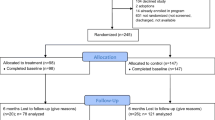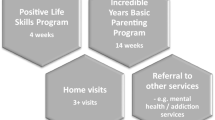Abstract
Perinatal child abuse prevention projects are increasingly favored but rarely evaluated. The paper describes an experimental evaluation of the Child Parent Enrichment Project (CPEP). Women were referred to the project during or just after pregnancy if identified as at-risk of engaging in child abuse by community professionals. Clients were randomly assigned to CPEP services (n=24) or traditional community services (n=26). CPEP services involved six months of home visiting by paraprofessional women and linkage to other formal and informal community resources. Multivariate Analysis of Covariance on posttest scores, controlling for pretest scores, show advantage for the CPEP group in prenatal care, birth outcomes, better reports of child temperament, and better indicators of child welfare. CPEP mothers tended to report better well-being. No significant differences were demonstrated for levels of formal and informal support. Reports of child abuse were similar for both groups. Consumer satisfaction indicates that clients valued the program. The preliminary results argue for further use and evaluation of perinatal child abuse prevention services.
Similar content being viewed by others
References
Altemeier, W. A., III, O'Connor, S. M., Sherrod, K. B., & Vietze, P. M. (1985). Prospective study of antecedents for nonorganic failure to thrive.Journal of Pediatrics, 106, 360–365.
Armstrong, K. (1983). Economic analysis of a child abuse and neglect treatment program.Child Welfare, 52, 3–10.
Armstrong, K., & Fraley, Y. L. (1985). What happens to families after they leave the program?Children Today, 14, 17–20.
Ayoub, C., Jacewitz, M. M., Gold, R. G., & Milner, J. S. (1983). Assessment of a program's effectiveness in selecting individuals “at risk” for problems in parenting.Journal of Clinical Psychology, 39, 334–339.
Barrera, M. Jr. (1981). Social support in the adjustment of pregnant adolescents: Assessment issues. In B. H. Gottlieb (Ed.),Social networks and social support. Beverly Hills, CA: Sage.
Barth, R. P. (1985). Beating the blues: Cognitive-behavioral treatment for depression in child maltreating young mothers.Clinical Social Work Journal, 13, 317–328.
Barth, R. P. (1986).Social and cognitive treatment of children and adolescents. San Francisco, CA: Jossey-Bass.
Barth, R. P., Hacking, S. D., & Rodriguez, J. L. (1986).Implementing home-based child abuse prevention services: A manual for the Child Parent Enrichment Project Unpublished manuscript, University of California, Berkeley, School of Social Welfare.
Barth, R. P., Hacking, S., & Ash, J. R. (1986). Screening, referring, and recruiting high-risk parents into child abuse prevention programs.Child Abuse & Neglect, 10, 99–109.
Barth, R. P., Schinke, S. P., & Maxwell, J. S. (1985). Coping skills training for school-age mothers.Journal of Social Service Research, 8, 75–94.
Belsky, J. (1980) Child maltreatment: An ecological integration.American Psychologist, 35, 320–325.
Carey, W. B. (1970). A simplified method for measuring infant temperament.The Journal of Pediatrics, 77 188–194.
Crnic, K. A., Greenberg, M. T., Robinson, N. M., & Ragozin, A. S. (1984). Maternal stress and social support: Effects on the mother-infant relationship from birth to eighteen months.American Journal of Orthopsychiatry, 54, 224–235.
Cutrona, C. E. (1984). Social support and stress in the transition to parenthood.Journal of Abnormal Psychology, 93, 378–390.
Enos, R., & Hisanga, M. (1979). Goal setting with pregnant teenagers.Child Welfare, 58, 541–552.
Fortune, A. E. (1985).Task-centered practice with families and groups. New York: Springer.
Gabinet, L. (1979). Prevention of child abuse and neglect in an inner-city population: The program and the results.Child Abuse and Neglect, 3, 809–817.
Goldberg, S. (1983). Parent-infant bonding: Another look.Child Development, 54, 1355–1382.
Gray, E.B. (1982). Perinatal support programs: A strategy for the primary prevention of child abuse.Journal of Primary Prevention, 2, 138–152.
Gray, E. B. (1983). What have we learned about preventing child abuse? An overview of the “community and minority group action to prevent child abuse and neglect.” Chicago, IL: National Committee For Prevention of Child Abuse.
Gray, J. D., Cutler, C. A., Dean, J. G., & Kempe, C. H. (1979). Prediction and prevention of child abuse and neglect.Journal of Social Issues, 35, 129–139.
Habif, V. L., & Lahey, B. B. (1980). Assessment of the life-stress depression relationship: The use of social support as a moderator variable.Behavioral Assessment, 2, 167–173.
Helfer, R. E. (1982). A review of the literature on the prevention of child abuse and neglect.Child Abuse and Neglect, 6, 251–161.
Helfer, R. E., Hoffmeister, J. K., & Schnieder C. (1978).MSPP: A manual for use of the Michigan screening profile of parenting. Boulder, CO: Express.
Hunter, R. S., & Kilstrom, N. (1979). Breaking the cycle of abusive families.American Journal of Psychiatry, 136, 1320–1322.
Klaus, M. H., & Kennell, J. H. (1982).Parent-infant bonding. St. Louis: Mosby.
Larson, C. P. (1980). Efficacy of parental and postpartum home visits on child health and development.Pediatrics, 66, 191–197.
Miller, K., Fein, E., Howe, G. W., Gaudio, C. P., & Bishop, G. V. (1984). Time-limited, goal-focused parent aid service.Social Casework, 65, 472–477.
Milner, J. S. (1980).The child abuse potential inventory, Manual. NC: Psytec Crop.
Milner, J. S., & Wimberley, R. C. (1979). An inventory for the identification of child abusers.Journal of Clinical Psychology, 35, 95–100.
Milner, J. S., & Wimberley, R. C. (1980) Prediction and explanations of child abuse.Journal of Clinical Psychology, 36, 875–884.
National Committee for Prevention of Child Abuse. (1983).Final report: Collaborative research of community and minority group action to prevent child abuse and neglect. Vol. 1: Perinatal interventions. Chicago, IL: Author.
Olds, D. L. (1982). The prenatal/early infancy project: An ecological approach to prevention of developmental disabilities. In J. Belsky (Ed.),In the beginning: Readings on infancy (pp. 270–285). New York: Columbia.
Payne, C. (1984).Programs to strengthen families: A resource guide. Chicago, IL: Yale University and the Family Resource Center.
Pearlin, I. L., & Schooler, C. (1978). The structure of coping.Journal of Health and Social Behavior, 19, 2–21.
Radloff, L. S. (1977). The CES-D scale: A self-report depression scale for research in the general population.Applied Psychological Measurement, 1, 385–401.
Rauh, V. A., Nurcombe, B., Ruoff, P., Howell, D. C., Teti, D. M., & Brennan, J. (1982). Facilitating maternal adjustment to the low birthweight infant: Effects of an intervention program. Presented at the Annual Meeting of the American Academy of Child Psychiatry, Washington, D.C.
Reid, W. J., & Epstein, L. (1972).Task-centered casework. New York: Columbia University Press.
Reid, W. J. (1978).The task-centered system. New York: Columbia University Press.
Salzinger, S., Kaplan, S., & Artemyeff, C. (1983). Mothers personal social networks and child maltreatment.Journal of Abnormal Psychology, 92, 68–76.
Shure, M. B., & Spivak, G. (1978).Problem-solving techniques in childrearing. San Francisco, CA: Jossey-Bass.
Siegel, E., Bauman, K. E., Schaefer, E. S., Saunders, M. M., & Ingram, D. D. (1980). Hospital and home support during infancy: Impact on maternal attachment, child abuse and neglect, and health care utilization.Pediatrics, 66, 183–190.
Spielberger, C. D., Gorsuch, R. L., & Lushene, R. E. (1970).Manual for the state-trait anxiety inventory. Palo Alto, CA: Consulting Psychologist Press.
TenBroeck, E. & Barth, R. P. (1986). Learning the hard way: A pilot permanency planning program.Child Welfare, 65, 281–294.
Whitey, V., Anderson, R. & Lauderdale, M. (1980). Volunteers as mentors for abusing parents: A natural helping relationship.Child Welfare, 59, 637–644.
Author information
Authors and Affiliations
Additional information
The authors thank Sharon Ikami and “CPEP” staff and volunteers. Richard P. Barth, D.S.W. is Associated Professor at the School of Social Welfare, University of California, Berkeley. Susan Hacking, Ph.D. was Project Director and Jordana Ash, M.S.W. is Child Welfare Worker, Alameda County Department of Social Services. Funding was provided by Bio-Medical Research Support Grant 2-507-RR07006 Resources from the Division of Research National Institute of Health, the State of California Office of Child Abuse Prevention, and the Office of Human Development Services ACYF, DHHS (Grant #90-CA-0998).
Rights and permissions
About this article
Cite this article
Barth, R.P., Hacking, S. & Ash, J.R. Preventing child abuse: An experimental evaluation of the child parent enrichment project. J Primary Prevent 8, 201–217 (1988). https://doi.org/10.1007/BF01695023
Issue Date:
DOI: https://doi.org/10.1007/BF01695023




